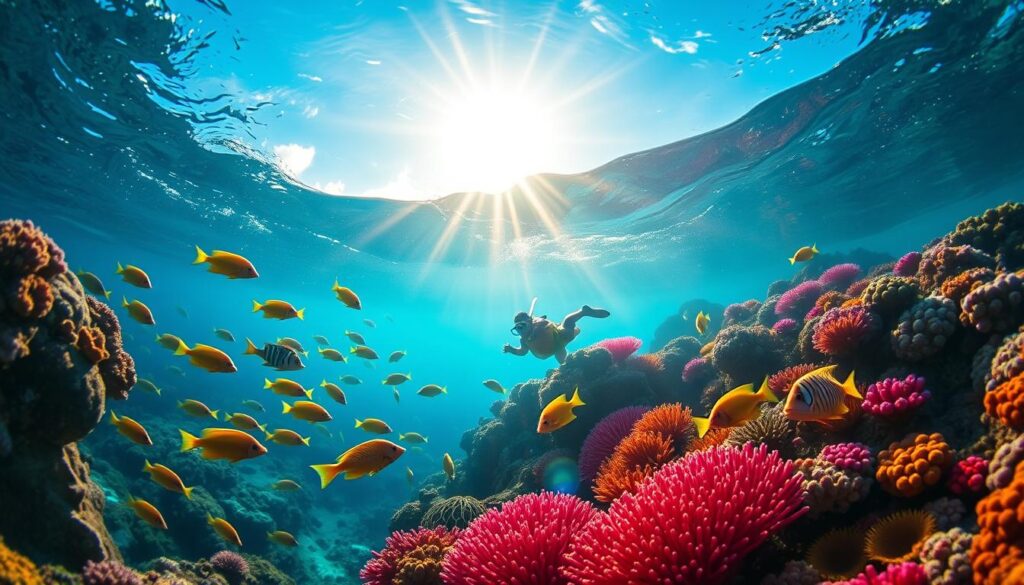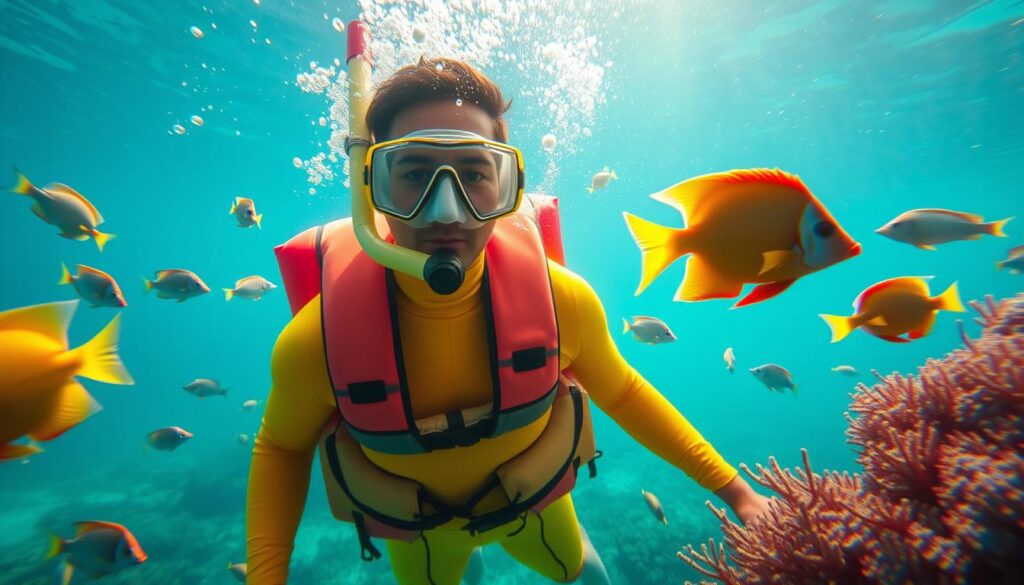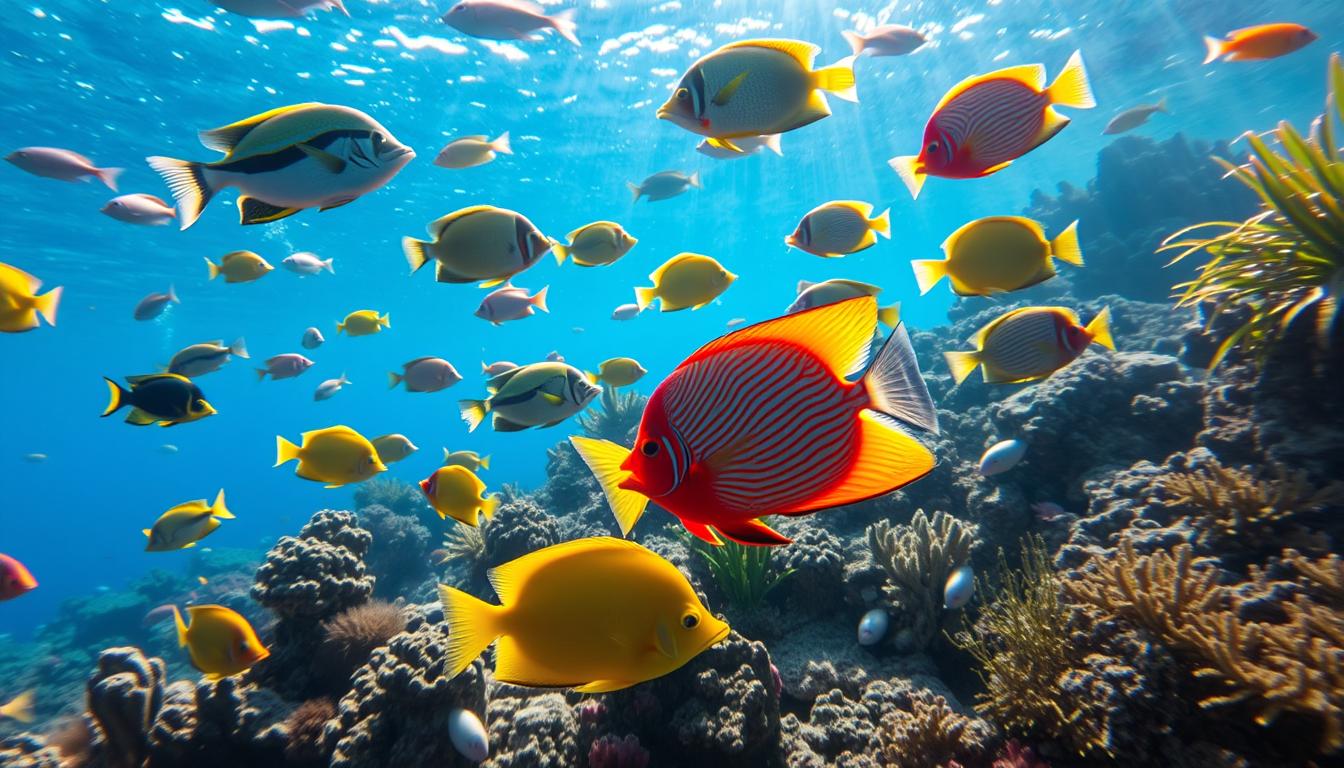Ever wondered what’s under Hawaii’s waters? Get ready for an exciting dive into the world of Hawaiian fish. We’ll show you over 25 unique species that live in Hawaii’s tropical waters.
What secrets do these creatures hold? How do they impact Hawaii’s marine life? Join us as we explore their cultural importance, how to spot them, and where to see them. Are you ready to discover Hawaii’s underwater wonders?
Table of Contents
Understanding Hawaiian Fish Diversity and Culture
Hawaii’s marine life is deeply connected to its culture. Fish like the humuhumunukunukuāpua’a (reef triggerfish) and the lau-wiliwili-nukunuku’oi’oi (long-nosed butterflyfish) are very important. They are not just part of the reefs but also play a big role in food, traditions, and heritage.
The Cultural Significance of Fish in Hawaii
In Hawaiian culture, fish symbolize abundance, prosperity, and connection to the sea. Traditional dishes like poi and poke are loved worldwide. Since the 1970s, there’s been a big interest in Hawaiian culture, showing how important fish are in arts, music, and festivals.
Hawaiian Fish Naming Traditions
The Hawaiian language has unique names for fish that describe their looks or behaviors. For example, the humuhumunukunukuāpua’a (reef triggerfish) is named for its sound. The lau-wiliwili-nukunuku’oi’oi (long-nosed butterflyfish) is named for its long snout. These names show how much Hawaiians value and understand their marine life.
Reef Ecosystems and Their Importance
The coral reefs around Hawaii are full of different fish, each important for the ecosystem. Fish like butterflyfish and parrotfish help keep the reefs healthy. It’s crucial to protect these reefs for Hawaii’s marine life.
Common Reef Fish Species in Hawaiian Waters
Hawaii’s marine ecosystem is full of colorful reef fish. You’ll see the Moorish Idol and the Convict Tang, among others. These fish are key to the coral reef’s health. They add beauty and balance to the underwater world.
The Moorish Idol stands out with its black, white, and yellow stripes. These fish swim in groups, showing off their unique style. The Convict Tang is also common, with its black-and-white stripes. They help keep the reef healthy by eating algae.
Hawaii’s waters are home to many butterflyfish species. Look for the Lemon “Milletseed” Butterflyfish and the rare Bluestripe Butterflyfish. These fish have beautiful colors and eat in pairs or small groups.
For a taste of Hawaiian cuisine, watch for ahi tuna and mahi-mahi. These fish are perfect for poke and are important in Hawaiian food culture.
With over 680 fish species, Hawaii’s reefs are a true wonder. Seeing these fish is a big part of enjoying Hawaii’s marine beauty and culture.
Unique Hawaiian Fish Identification Guide
Explore the colorful world of Hawaiian fish with our guide. Learn to spot the Long-Nosed Butterflyfish by its long snout. See the Sailfin Tang with its sail-like fins. Discover the unique colors and behaviors of tropical fish.
Physical Characteristics
Identifying Hawaiian fish starts with their unique features. Look for the Long-Nosed Butterflyfish’s long snout. The Sailfin Tang has fins that look like a sail. Also, notice the bright colors and patterns of fish like the Ornate Butterflyfish and the Orangeband Surgeonfish.
Color Patterns and Markings
Hawaiian fish have stunning colors and patterns. The Convict Tang has black and white stripes. The Orangeband Surgeonfish has bold orange bands. These colors help identify different fish.
Behavioral Traits
Watching how Hawaiian fish behave can also help identify them. Notice how the Trumpetfish hunts. See how triggerfish show their territory. These behaviors can tell you which fish you’re looking at.
By learning about Hawaiian fish features, colors, and behaviors, you can become an expert. You’ll unlock the secrets of these underwater creatures. You’ll be a pro at identifying fish in the Hawaiian fish guide.
Popular Hawaiian Fish for Snorkeling Encounters
Start your underwater journey in Hawaii and explore the colorful world of tropical marine life. You’ll see the Moorish Idol and the Reef Triggerfish, among others. These fish are perfect for snorkeling and will amaze you.
Look out for the Orangeband Surgeonfish and the Convict Tang. They are easy to spot in their natural home. These fish live in the coral reefs along Hawaii’s coast, making your snorkeling trip unforgettable.
When snorkeling, know the best times and places to see these amazing fish. Visit famous spots like Hanauma Bay on Oahu or Molokini Crater in Maui. This way, you’ll see many different fish species.
It’s important to snorkel responsibly. Use reef-safe sunscreen and keep a safe distance from the fish. This helps protect the marine environment and ensures a great experience for everyone.
| Fish Species | Characteristics | Ideal Snorkeling Locations |
|---|---|---|
| Moorish Idol | Striking black, yellow, and white coloration; distinctive long, tapered dorsal fin | Hanauma Bay Nature Preserve, Molokini Crater |
| Humuhumunukunukuāpua’a (Reef Triggerfish) | Unique, rectangular body shape; brightly colored patterns | North Shore Oahu, Kealakekua Bay |
| Orangeband Surgeonfish | Graceful, disc-like body; vibrant orange and blue hues | Kealakekua Bay, Kapalua Bay |
| Convict Tang | Distinctive black and white striped pattern; common and easily identified | Hanauma Bay Nature Preserve, Kealakekua Bay |
| Hawaiian Sergeant | Bold black and white stripes; often found in large schools | North Shore Oahu, Kapalua Bay |

Dive into the vibrant world of Hawaiian fish. Learn about the most popular species and the best snorkeling spots. This will help you plan an amazing snorkeling adventure in Hawaii’s tropical paradise.
Territorial and Defensive Fish Species
Exploring Hanauma Bay’s underwater world requires awareness of territorial fish. Triggerfish, with their unique looks and protective nature, are especially interesting. They can be quite dangerous.
Trigger Fish Behavior
The triggerfish family, Balistidae, has about 40 species in tropical oceans. They are known for their bright colors and strong jaws. These fish are very protective of their territory, especially when they’re breeding.
Male triggerfish guard their territory and host multiple females. They take turns caring for the eggs. Some, like the Picasso Triggerfish, can be very aggressive when defending their nests.
Safe Viewing Distances
It’s important to keep a safe distance from triggerfish. The Humuhumunukunukuāpua’a and Black Durgon Triggerfish are known for their defensive behavior. Staying a few feet away helps avoid any trouble.
Warning Signs to Watch For
- Raised dorsal spines: A sign that the fish is feeling threatened and may be preparing to defend its territory.
- Rapid color changes: Triggerfish can quickly change their color patterns, often as a warning signal to potential intruders.
- Aggressive posturing: Triggerfish may swim towards you with their mouths open, a clear indication that they feel threatened and are ready to defend their territory.
Understanding triggerfish behavior lets you enjoy watching them safely. Always respect their space and enjoy their beauty from a distance.
Best Locations to Spot Hawaiian Fish
Exploring Hawaii’s vibrant marine life is a must for visitors. From famous hawaiian snorkel spots to diverse fish watching locations, the islands are full of opportunities. Let’s explore the top spots to see Hawaiian fish and discover the hidden treasures of these coral reefs.
Hanauma Bay on Oahu is a top hawaiian snorkel spot. It’s a marine life conservation area with over 400 fish species. Arrive early to beat the crowds and enjoy the clear waters filled with colorful marine life.
Molokini Crater off Maui’s coast is another famous fish watching location. This crescent-shaped islet has great visibility and many fish species, including reef sharks. Snorkeling or scuba diving here is an unforgettable experience.
Kauai’s hawaiian snorkel spots like Makua Beach and Poipu Beach Park are great for spotting marine life. Makua Beach has big coral formations and lots of sea life. Poipu Beach Park is good for families and you might see Hawaiian Green Sea Turtles.
When visiting these fish watching locations, choose responsible tour operators. Follow local guidelines and respect the coral reefs and marine ecosystems. This way, you help protect these natural wonders for future generations.
The best time to visit these hawaiian snorkel spots depends on the season and weather. Talk to local experts, check surf reports, and plan your trip well. This will help you have the best underwater adventure in Hawaii.
Conservation Status of Hawaiian Fish
Hawaii’s oceans are home to many fish species. But, many of these face threats and need our help. It’s important to know about the conservation status of these marine animals to save them.
Protected Fish Species
Some Hawaiian fish are protected or endangered. The Hawaiian monk seal, green sea turtle, and hawksbill sea turtle are among them. In March 2024, the U.S. Fish and Wildlife Service protected 119,326 acres for 12 endangered species on the Island of Hawai’i.
Environmental Threats
Hawaii’s marine life is threatened by overfishing, coral bleaching, and pollution. These issues shrink their habitats, making them more likely to disappear. Protecting their habitats is key to saving them.
Conservation Efforts
There are many efforts to save Hawaii’s marine life. Marine protected areas and sustainable fishing are part of it. The Endangered Species Act has helped save 99% of listed species. By supporting these efforts, we can help protect Hawaii’s oceans.
Safety Tips for Fish Watching
Exploring Hawaii’s marine life is exciting, but safety comes first. Whether you’re snorkeling or watching from the shore, these tips will keep you safe and happy.
Respect the Marine Life Etiquette
- Keep at least 10-15 feet away from all fish, especially territorial ones like triggerfish.
- Don’t touch, feed, or disturb the marine creatures to keep their natural behaviors and habitats intact.
- Be careful with your movements and avoid sudden gestures that might scare the fish.
Practice Responsible Snorkeling Techniques
- Make sure you know how to snorkel before you go in the water.
- Wear sun protection like a rash guard or wetsuit to avoid sunburn.
- Watch the ocean conditions and stay alert to avoid dangers.
Support Conservation Efforts
- Choose eco-friendly tour operators that focus on sustainable practices and marine conservation.
- Don’t harm or damage coral reefs and other delicate marine habitats.
- Report any suspicious activity that could harm marine life to the authorities.
By following these safety tips and respecting marine life etiquette, you’ll have a great time watching fish in Hawaii’s waters.

Conclusion
Hawaiian fish species are key to the region’s ecology, culture, and tourism. From the iconic Humuhumunukunukuāpua’a to the mesmerizing Moorish Idol, each fish is unique. They show off their own special traits and how they adapt.
Looking into the jaw structures and how they eat, like triggerfish, shows their complexity. Their evolution shows how they adapt to changes in their world. This is thanks to changes in their jaws and how they connect.
By following responsible fish watching practices and supporting conservation, you help protect hawaiian marine biodiversity. You also help keep the island fish species alive for future generations. As you explore the underwater world, always remember to respect and protect it.

